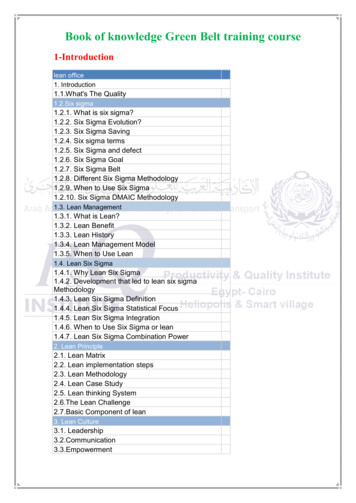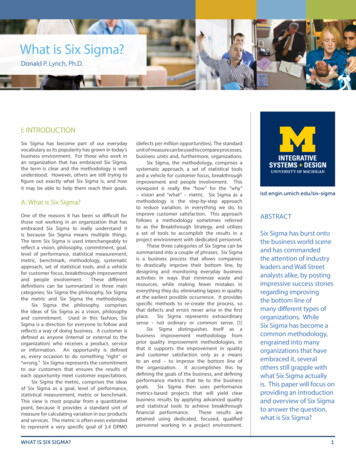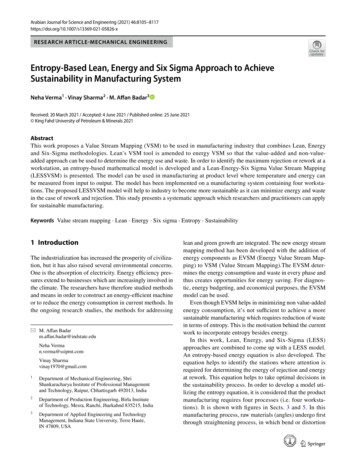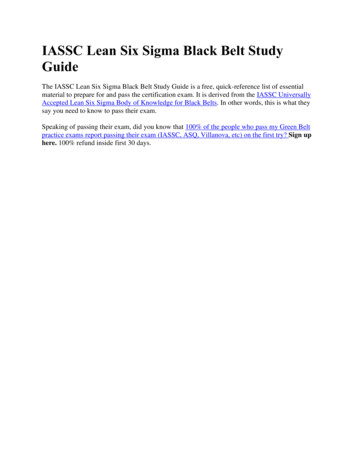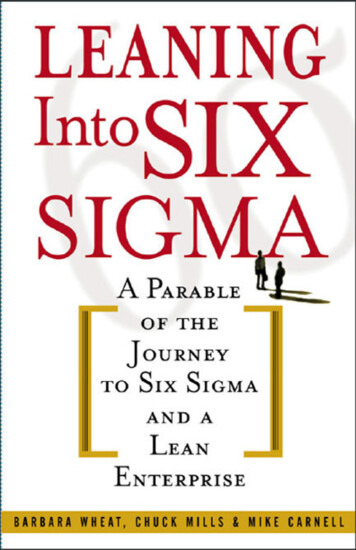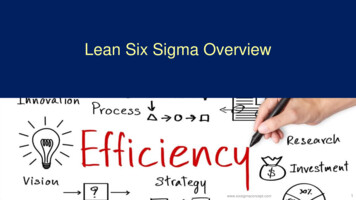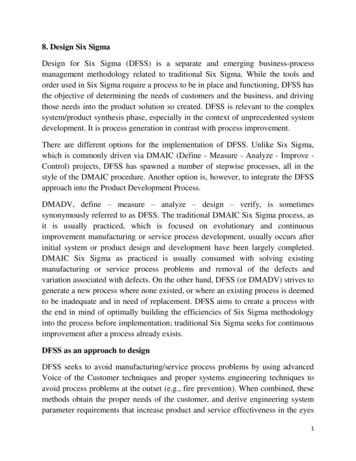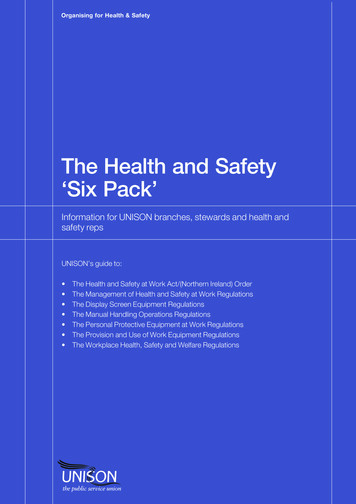
Transcription
Organising for Health & SafetyThe Health and Safety‘Six Pack’Information for UNISON branches, stewards and health andsafety repsUNISON’s guide to: The Health and Safety at Work Act/(Northern Ireland) OrderThe Management of Health and Safety at Work RegulationsThe Display Screen Equipment RegulationsThe Manual Handling Operations RegulationsThe Personal Protective Equipment at Work RegulationsThe Provision and Use of Work Equipment RegulationsThe Workplace Health, Safety and Welfare Regulations
UNISON’s Health and Safety reps guideB
ContentsIntroduction1Chapter 1The Health and Safety at Work Act 1974/(Northern Ireland) Order 19782Chapter 2:The Management of Health and Safety at Work Regulations5Summary of duties and rights5Regulation 1:Date and title6Regulation 2:Exclusions6Regulation 3:Risk assessments6Regulation 4:Principles of prevention7Regulation 5:Health and safety arrangements8Regulation 6:Health surveillance8Regulation 7:Health and safety assistance9Regulation 8:Procedures for serious and imminent dangers and dangerous areas10Regulation 9:Contact with external services11Regulation 10:Information for employees11Regulation 11:Co-operation between employers11Regulation 12:Working on other people’s premises11Regulation 13:Capabilities and training12Regulation 14:Employees’ duties13Regulation 15:Temporary workers13Regulation 16-18:New and expectant mothers13Regulation 19:Young workers14Checklist for assessing management actionChapter 3:The Display Screen Equipment Regulations1517Summary of duties and rights17Regulation 1:Definitions17Regulation 2:Assessment of workstations19Regulation 3:Workstation standards20Regulation 4:Breaks and changes of activity20Regulation 5:Eye and eyesight tests20Regulation 6:Health and safety training21Regulation 7:Information22The ScheduleMinimum requirements for workstations22Chapter 4:The Manual Handling Operations Regulations25Summary of duties and rights25Regulations 1-3:Definitions and application26Regulation 4:Employers’ duties26Regulation 5:Employees’ duties31Guidance on the Manual Handling Regulations31
UNISON’s Health and Safety reps guideChapter 5:The Personal Protective Equipment at Work Regulations32Summary of duties and rights32Regulation 1 - 2:Date, title and definition of ‘personal protective equipment’33Regulation 3:Equipment not covered by these Regulations33Regulation 4:Provision of PPE34Regulation 5:Compatibility of PPE with other equipment35Regulation 6:Assessment of PPE35Regulation 7:Maintenance and replacement of PPE35Regulation 8:Storage for PPE35Regulation 9:Information, instruction and training36Regulation 10:Employees’ duties to use PPE36Regulation 11:Employees’ duties to report loss or defects37The Provision and Use of Work Equipment Regulations38Chapter 6:Summary of duties and rights38Regulation 1:Date and title39Regulation 2:Definition of ‘work equipment’ and ‘use’39Regulation 3:General duties of employers, the self-employed, and those incontrol of equipment39Regulation 4:Suitable work equipment39Regulation 5:Maintenance40Regulation 6:Inspection40Regulation 7:Specific risks41Regulation 8:Information and instructions41Regulation 9:Training41Regulation 10:European Community requirements41Regulation 11:Dangerous parts of machinery41Regulation 12:Protection against specified risks42Regulation 13:High or low temperatures42Regulation 14:Controls for starting equipment42Regulation 15:Control stops42Regulation 16:Emergency stop controls43Regulation 17:Controls43Regulation 18:Control systems43Regulation 19:Isolating from energy sources43Regulation 20:Stability of equipment43Regulation 21:Lighting43Regulation 22:Maintenance operations43Regulation 23:Markings43Regulation 24:Warnings44Regulations 25–30:Mobile work equipment44
Chapter 7:The Workplace Health, Safety and Welfare Regulations45Summary of duties and rights45Regulation 1:Dates when these Regulations came into force46Regulation 2:Definitions and coverage46Regulation 3:Application to building and temporary sites, etc46Regulation 4:Responsibilities of employers47Regulation 5:Maintenance47Regulation 6:Ventilation48Regulation 7:Temperature48Regulation 8:Lighting49Regulation 9:Cleanliness49Regulation 10:Room dimensions and space49Regulation 11:Workstations and seating49Regulation 12:Floors50Regulation 13:Preventing falls or falling objects50Regulation 14:Windows and transparent or translucent doors and walls, etc50Regulation 15:Windows, skylights and ventilators50Regulation 16:Safety of window cleaning50Regulation 17:Pedestrian and vehicular traffic routes on site51Regulation 18:Doors and gates51Regulation 19:Escalators and moving walkways51Regulation 20:Toilets51Regulation 21:Washing facilities51Regulation 22:Drinking water52Regulation 23:Accommodation for clothing52Regulation 24:Changing facilities53Regulation 25:Restrooms and meal facilities53Regulation 25A:Disabled Persons53Further information and advice54Chapter 8:UNISON guidance and other materials54The TUC and HSE Guidance and other materials54Specific help, advice and case studies54
UNISON’s Health and Safety reps guideIntroductionThis is a guide for UNISON health and safetyrepresentatives on a group of six Regulationspopularly known as ‘the health and safety six pack’.These are:—— The Management of Health and Safety at WorkRegulations—— The Display Screen Equipment Regulations—— The Manual Handling Operations Regulations—— The Personal Protective Equipment at WorkRegulations—— The Provision and Use of Work EquipmentRegulations—— The Workplace Health, Safety and WelfareRegulationsThese Regulations have been amended andupdated at various times. They implement variousEuropean Directives on health and safety. They alsoclarify how employers must comply with their dutiesunder the Health and Safety at Work Act 1974 (forGreat Britain) or the Health and Safety at Work(Northern Ireland) Order 1978 (for Northern Ireland).The purpose was to harmonise health and safetylegislation throughout Europe. Some of the six packRegulations have Approved Codes of Practice(ACoPs) and/or official Guidance produced orapproved by the Health and Safety Executive (HSE)(for GB) or the Health and Safety Executive NorthernIreland (HSENI). These give practical advice on whatshould be done to comply with the law. Employersand others do not have to follow ACoPs. However,if a court asks, they need to be able to prove that ifthey do not, their alternative arrangements have thesame or better standards of health and safety. Theofficial Guidance is not legally enforceable, but doesindicate the standards and procedures that will beexpected by health and safety inspectors.This UNISON guide summarises the Regulations,the Codes, and the Guidance. When the word‘must’ is used within the guide, this refers to a legal1requirement, either a Regulation or ACoP. The word‘should’ indicates advice from the official Guidance.This guide also gives a brief introduction to theHealth and Safety at Work Act (for GB) and Healthand Safety at Work Order (for NI), and in chapter 8,refers to other sources of information, including otherimportant health and safety laws.
Chapter 1: The Health and Safety at Work Act1974/(Northern Ireland) Order 1978This Act and Order were designed to ensure that allworkers in all occupations were covered by healthand safety law. Rather than lots of different lawscovering different groups, they provide a frameworkwithin which all work related health and safetycan be regulated under the same principles.Reasonably practicableThe Act and Order are written in very generalterms and the duties on employers arequalified with the words ‘as far as is reasonablypracticable’. This means that where there is a riskof harm which cannot be prevented or avoided,then employers are expected to take “reasonablypracticable” steps (appropriate action) to controlor minimise the risks. Put simply, the more likelyit is that harm will occur, and the more seriousthat harm could be, the more the employer isexpected to do. However, some employershave wrongly used this to argue that the costsof a particular safety measure are too highto do anything. See UNISON’s guide on riskassessment for more information on this – furtherdetails in chapter 8.Just below, are summaries of the main sectionsof the Health and Safety at Work Act or the mainarticles of the Health and Safety at Work Order.Section 1/Article 3This states the general purpose of Part 1 of the Actor Part 2 of the Order, which is:—— Controlling certain harmful or unpleasantemissions into the air from certain premises.Section 2/Article 4This puts a general duty on employers to:—— Ensure the safety, health and welfare at work oftheir employees.—— Consult on arrangements for action on health andsafety matters with duly appointed trade unionsafety reps.—— Establish a health and safety committee ifrequested by the trade union safety reps. SeeUNISON’s guide on the Safety Representativeand Safety Committee Regulations for moreinformation on this – further details in chapter 8.—— Prepare and publicise a written statement of theirsafety policy and arrangements.This section/article also makes provision byRegulations for the appointment of workers’ safetyreps by recognised trade unions. This led to theSafety Representative and Safety CommitteeRegulations. UNISON’s guide gives more informationon these – further details in chapter 8.Section 3/Article 5This places a general duty on employers and theself employed to ensure that their activities do notendanger anybody. In certain circumstances, theyare also required to provide information to the publicabout any potential hazards to health and safety.—— Maintaining or improving standards of health,safety and welfare of people at work.—— Protecting other people against risks to healthand safety arising out of work activities.—— Controlling the storage and use of dangeroussubstances.2
UNISON’s Health and Safety reps guideNote on the Self-EmployedSection 6/Article 7Since 1 October 2015, the self-employed inGreat Britain have not had to follow health andsafety law if their work activity poses no potentialrisk to the health and safety of other workers ormembers of the public.This places duties on anyone who designs,manufacturers, imports or supplies an article orsubstance for use at work. They must ensure so faras is reasonably practicable see, that the article orsubstance is safe and without risk to health whenused, cleaned or maintained in accordance withthe information supplied by them. See page 2 foran explanation of what is meant by ‘reasonablypracticable.’ The duty also requires the provision ofnecessary, up-to-date and revised information andthe carrying out of necessary testing, inspection andresearch. Those who install plant also have a duty toensure that it is safely installed.However, certain types of work are specificallylisted (prescribed) so that it is clear thathealth and safety law will always apply to theself-employed in these areas. They include:agriculture, asbestos, construction, gas,genetically modified organisms, and the railways.Also note, that being self-employed for tax andnational insurance purposes does not guaranteebeing recognised as self-employed for health andsafety purposes.For more information, go to the Health and SafetyExecutives (HSEs) website: www.hse.gov.uk/selfemployed.Section 7/Article 8This places duties on employees to take reasonablecare to ensure that they do not endanger themselvesor anyone else who may be affected by their workactivities. It also requires them to co-operate withemployers and others in meeting legal requirements.Section 8/Article 9Section 4/Article 6This places a duty on anybody responsible forplaces of work to ensure that the premisesthemselves, as well as plant and machinery in them,do not also endanger people using them who arenot employees.Section 5Anyone in control of certain prescribed premisesmust use the best practicable means to preventnoxious or offensive (harmful or unpleasant)substances being emitted into the atmosphere. Anysubstances that are emitted must have been madeharmless and inoffensive.Note that there is no equivalent article in theOrder for NI, but the requirements by thissection are likely to be far more developed byenvironmental law. So if this section is of interest,the relevant environmental laws for GB and NIshould also be checked.3This places a duty on everyone not to misuseanything provided in the interests of health or safetyat work under a legal requirement.Section 9/Article 10This provides that no employer may chargetheir employees for anything done or equipmentprovided for health or safety purposes under a legalrequirement.Section 15/Article 17This section/article allows the appropriategovernment minister to make Regulations on healthand safety under the Act or Order. This is howthe health and safety six pack Regulations wereintroduced.Section 28(8)/Article 30(9)This requires health and safety inspectors to supplycertain information on health, safety and welfarematters affecting safety, to the relevant workers ortheir representatives.
Other sections/articlesThe other sections or articles of the Health andSafety at Work Act or Order not mentioned above,are more about procedures and administrativearrangements. These cover the creation andoperation of the Health and Safety Executive (HSE)(for GB) or the Health and Safety Executive NorthernIreland (HSENI), Approved Codes of Practice(ACoPs) and their use in legal proceedings, and whoenforces health and safety law and how, etc.To see what the Act or Order means in practice, itis necessary to look at the regulations made underthem, or the official ACoPs and Guidance.4
UNISON’s Health and Safety reps guideChapter 2: The Management of Health and Safetyat Work RegulationsSummary of duties and rightsThese (Management) Regulations cover some ofthe main general principles for ensuring health andsafety at work, including the requirement to riskassess. They cover employers, the self-employed,and employees. However, since 1 October 2015, theself-employed can be specifically exempt from anyduties they might otherwise have had under healthand safety law. However, this is only if their workactivity poses no potential risk to the health andsafety of other workers or members of the public,and their work is not on the prescribed list of typesof work that cannot be exempted. See page 3 forfurther detail.These Regulations are wide ranging, expand therights of trade union safety reps, and may overlapwith more specific topic based Regulations. Wherethis is the case, compliance with the “topic”Regulations will normally be sufficient to comply alsowith the Management Regulations. However, if theManagement Regulations go further then these alsoneed to be complied with.For Great Britain the accompanying ApprovedCode of Practice (ACoP) and Guidance to theseRegulations were withdrawn in 2013, but therequirements under the Regulations did not alter.Also, the Health and Safety Executive (HSE) websitestill has various Guidance on managing health andsafety, aimed at different sized employers, and thiscan be found at: http://www.hse.gov.uk/managing/index.htm. In Northern Ireland, the accompanyingACoP and Guidance is still in use. For the purposesof this UNISON guide, there is no difference to thecontent either way, with it equally reflecting the ACoPand Guidance in NI and the web based Guidance forGB.needed to avoid hazards or minimise or controlrisks so far as is reasonably practical. Seepage 2 for an explanation of what is meant by‘reasonably practicable.’ There are specificrequirements in respect of young workers,new and expectant mothers and women ofchildbearing age. Employers with five or moreemployees must record the significant findings ofthe risk assessment.However, it is good practice for all employers evensmall ones, to do this as well. Having this recordshows that they have carried out a risk assessmentshould a health and safety inspector visit. It willalso act as a future reminder to check that theyhave done everything that was required, and helpconsider whether anything more can be done whencarrying out a review.—— Make arrangements for implementing the healthand safety measures identified as being requiredby the risk assessment. These arrangementsmust cover health and safety planning,organisation, control, monitoring and review asappropriate. Again, employers with five or moreemployees must record their arrangements.—— Appoint competent people to help withthe implementation of health and safetyarrangements.—— Set up emergency procedures.—— Provide information to employees which can beunderstood, as well as adequate training andinstruction.—— Work together with other employers sharing thesame workplace.Employees’ duties are to:Employers’ duties are to:—— Use equipment and dangerous substances inaccordance with the training they have received.—— Assess the risks to the health and safety of theiremployees and others who may be affected bythe business or work to identify the measures—— Report dangerous situations and anyshortcomings in their employers’ health andsafety arrangements.5
Rights of trade union safety reps are:—— To be consulted by their employer in good timeon: Any measure which may substantially affect thehealth and safety of employees whom the safetyrep represents. The appointment of competent people to providehealth and safety assistance to the employer. The appointment of people to overseeemergency procedures. Any health and safety information provided toemployees whom the safety rep represents. The planning and organising of health and safetytraining. The health and safety effects of newtechnologies. Safety reps must be consulted fromthe planning stage.—— To have provided by the employer any facilitiesand assistance that safety reps may reasonablyrequire to carry out their safety rep functions.These rights expand upon the safety reps rights toconsultation under the Safety Representative andSafety Committee Regulations, and are includedwithin them as Regulation 4A. UNISON’s guide givesmore information on these Regulations – furtherdetails in chapter 8.The Regulations step by stepRegulation 1: Date and titleThe Management of Health and Safety at WorkRegulations first came into force in 1993 and havebeen amended a number of times.Regulation 2: ExclusionsSo far as UNISON members are concerned, theseRegulations apply to all workplaces as the few partialexceptions are unlikely to apply. The exceptionscover work on a ship at sea; and short term oroccasional work involving domestic service in aprivate household or work that is safe and done by ayoung worker in a family business.Regulation 3: Risk assessmentsAll employers must make a ‘suitable and sufficient’assessment of health and safety risks to:—— Employees whilst at work, and—— Other people not employed by that employer.This covers visitors, agency staff and contractors,and members of the public including patients,clients, pupils and students.The purpose of this risk assessment is to identifymeasures needed to bring health and safetystandards up to the legal requirements. So it is notenough for employers to make an assessment andthen forget about the results. Remember that as wellas specific and topic based laws, employers mustalso comply with the general requirements of theHealth and Safety at Work Act or Order.Self-employed workers have a similar duty to assessrisks to themselves and others. This is worth notingin connection with contractors and agency staff whoare self-employed. Remember the exemption in GBfrom health and safety law only applies to the dutiesself-employed persons would otherwise have owed,and only if their work is not prescribed, and posesno potential risk to the health and safety of others.See page 3 for further detail.—— For young people (below 18), the Regulationsare clear that employers must not employthem unless they have carried out or revieweda risk assessment (as described above) whichalso specifically takes their health and safetyinto account. So this can be the same riskassessment as above, as long as young workersare covered by it, and the following factors arespecifically considered: Their inexperience, lack of awareness of risks,and immaturity; The fitting-out and layout of the workplace andthe workstation; The type, length, and how they may be exposedto physical, biological, and chemical agents andsubstances;6
UNISON’s Health and Safety reps guide The type and use of work equipment and how itis used; How processes and activities are organised; and The extent of health and safety training providedin general or specifically to young persons.An assessment must be reviewed if:—— There is reason to suspect it is no longervalid. Reasons could include complaints fromemployees or union reps, accident and illnessrecords, warnings from enforcement agencies.—— There has been a significant change in thematters to which it relates. For example,changes in work methods, staffing, shiftpatterns, equipment, chemicals, managementresponsibilities or structure could all make anassessment out of date and in need of review.Employers with five or more employees must record(paper or electronically):—— Significant findings of the assessment.—— Any group of employees especially at risk.However, it is good practice for all employers evensmall ones, to do this as well. Having this recordshows that they have carried out a risk assessmentshould a health and safety inspector visit. It willalso act as a future reminder to check that theyhave done everything that was required, and helpconsider whether anything more can be done whencarrying out a review.Safety reps have a right to see copies of theassessment records, and should check that all jobs,workplaces and workers (including any away fromthe employer’s premises) have been fully assessed.Decisions about which findings are ‘significant’will vary, so safety reps should get involved in riskassessments from the start and insist on copies ofall the results.Further and more detailed guidance on how safetyreps can check their employers risk assessments,including the measures of prevention and control, iscovered in UNISON’s guide on risk assessment. Seechapter 8 for further details.Regulation 4: Principles of preventionWhen implementing the measures of prevention andcontrol from risk assessments, employers must do iton the basis of a set of general principles which areincluded in the Regulations. These are:—— Avoid the risk (or hazard) so far as is reasonablypractical. For example clean upstairs windowsfrom the ground by using an extendable pole andthereby avoid the risk of a fall from height. Seepage 2 for further explanation of what is meant by‘reasonably practicable.’—— Evaluate (assess) the risks which cannot beavoided.—— Combat the risk at source. If for example,materials are received in heavy packages, ask forsmaller packages or units to be delivered.—— Adapt the work to the individual (especially thedesign of workplaces, choice of work equipment,and ways of working).—— Adapt to technical progress and advances whichmay be safer.—— Replace the dangerous by the non-dangerous orless dangerous. For example use water basedpaint in place of solvent based paint. However,when doing this, employers need to risk assessthe replacement for any new or potentially worsehazards.—— Develop a coherent prevention policy to cover allthe areas of work.—— Prioritise collective protective measures overindividual protective measures. For example, ifthere is a risk of a fall from a work platform, installa barrier in preference to providing personalprotective equipment such as safety harnesses.—— Give appropriate instructions to employees.7
Regulation 5: Health and safetyarrangementsAll employers must make and put into effectarrangements for the effective:—— planning,—— organisation,—— control,—— monitoring, and—— review,of their measures to prevent and control exposureto hazards and to manage health and safety morebroadly.Employers must have an effective health and safetymanagement system. Whilst the Regulation stillrefers to: planning, organisation, control, monitoring,and review; the HSE’s guide, Successful Healthand Safety Management (HSG65) now refers toplan, do, check and act. It outlines the expectationson employers to manage health and safety in theworkplace:—— Plan – policies, aims, and targets on health andsafety legal requirements including potentialemergencies.—— Do – assess risks; apply measures of control andprevention; involve, train, instruct and superviseworkers; and provide the right tools andequipment for the work.—— Check – ensure plans are implemented; assessif risks are controlled and how well aims andtargets are met; and investigate causes ofaccidents, incidents, and near-misses.—— Act – review performance; revisit polices, plans,and risk assessments; learn from and take actionfollowing accident investigations, incidents, andill-health data, near-miss reports, and the resultsof any monitoring or auditing, etc.Employers of five or more employees must recordtheir arrangements, but it is best practice forall employers to do so (see earlier). Safety repsshould use their rights to be consulted about thesearrangements and to receive copies of appropriaterecords.Regulation 6: Health surveillanceWhere risks remain (as identified by the riskassessment), employers must ensure thatemployees are provided with appropriate healthsurveillance. For health surveillance to beappropriate, there must be:—— an identifiable disease or adverse health effectrelated to the type of work,—— a reasonable likelihood that the disease or effectwill occur, and—— a valid technique for detecting early signs ofthese, and which is not a risk to the employee.The Control of Substances Hazardous to HealthRegulations (COSHH) covers this requirementin more detail for workers exposed to certainhazardous substances including chemicals andbiological substances. See UNISON’s guide onhazardous substances at work for more informationon this – further details in chapter 8.Regulation 6 extends this provision to coverother workers, for example, workers at risk frommusculoskeletal disorders such as repetitive straininjury (RSI) or back injury.Health surveillance may also be required where thereis exposure to noise, vibration, ionising radiation,asbestos, and lead; where other specific Regulationsmay apply.Further information on this is available from the HSEwebsite at http://www.hse.gov.uk/managing/index.htm.8
UNISON’s Health and Safety reps guideHealth surveillance should not be used instead ofpreventing or reducing risks. Nor should it be used,as a means of preventing future compensationclaims, by getting rid of staff susceptible to harmor who start showing signs of injury or illness.UNISON branches may want to negotiate relocationagreements for employees who are no-longer able todo their present job.Regulation 7: Health and safety assistanceAll employers must appoint one or more competentpersons to assist them to comply with their legalduties. Employers and self-employed workers canappoint themselves, but only if they are competentin health and safety. Larger employers are likely toappoint others to assist them. Competent personscan be employees or outside consultants andmay work full or part time on health and safetyassistance.However, where there is a competent person alreadydirectly employed by the employer, that personmust be appointed in preference to a competentperson not in their employment. This restricts anemployers ability to outsource or sub-contract thisrole. Also note that they cannot avoid their ownhealth and safety duties by appointing competentpeople to assist them, employers still remain legallyresponsible.Whoever is appointed as a competent person,employers must ensure:—— They are competent (see box below)—— There are enough competent people.If an outside consultant is appointed, the employermust:—— Inform the consultant of factors known, orsuspected to affect the health and safety ofemployees or others.—— Allow the consultant access to the sameinformation that employees are entitled to (seeRegulation 10). Competent people who areemployees should also receive this information asemployees.Competent personsThe definition of a competent person in theseRegulations is someone who ‘has sufficienttraining and experience or knowledge andother qualities to enable him (or her) properly toassist in undertaking (preventive and protective)measures’. To be competent the individualappointed should have a knowledge andunderstanding of: The work being assessed. The applicable hazards. The principles of risk assessment andprevention of risk. Up-to-date health and safety measures.They should also be able to: Identify health and safety issues. Assess the need for action. Design, develop and implement strategiesand plans. Check the effectiveness of these strategiesand plans. Promote health, safety and welfare advancesand good practices. Know their limitations and when to call forothers with specialist skills or expertise.—— They are allowed adequate time.—— They have adequate resources to carry outtheir functions. What is ‘adequate’ must beassessed by taking into account the size of theorganisation, the risks to employees, and thedistribution of those risks.—— They are informed about anyone who isemployed under a fixed term contract or is froman agency.9
Safety reps should use their rights to be consultedon the appointment of competent people, the boxabove on competent people should be of help withthis. Try to agree clear criteria for appointments andthe provision of training, time and information.If members are offered this role, make sure thatthey get adequate training and time off other workto carry out their functions as competent people.This additional training and skills could also lead tomembers being regraded. Safety reps should not begiven this role just becaus
Checklist for assessing management action 15 Chapter 3: The Display Screen Equipment Regulations 17 Summary of duties and rights 17 Regulation 1: Definitions 17 Regulation 2: Assessment of workstations 19 Regulation 3: Workstation standards 20 Regulation 4: Breaks and chang
